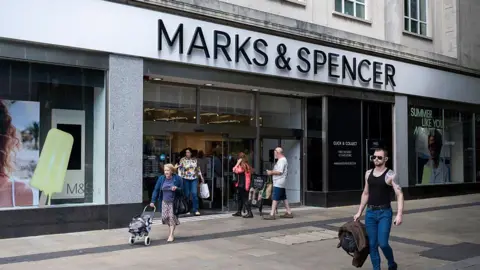In a recent dramatic revelation concerning the renowned UK retailer Marks & Spencer, the company’s chair, Archie Norman, testified before Members of Parliament (MPs) regarding an alarming cyber attack that occurred in April. According to Norman, the attacks were conducted by a hacker group known as DragonForce, whose motives, while not entirely clear, undoubtedly included elements of ransom or extortion. This statement has laid bare the extent of the damage inflicted upon the organization and emphasizes the ongoing struggles that M&S currently faces due to this incident.
The ramifications of this cyber attack on Marks & Spencer were profound, resulting in a halt of online orders and empty store shelves, which severely impacted customer experiences and expectations. Norman explained that the effects would linger into the following months, with a recovery projected to continue until the end of July. As he conveyed these insights in front of the Business Select Committee, Norman described the ordeal as “trying to destroy” the business, showcasing the potentially catastrophic consequences of such cyber threats.
Norman elaborated on the impact of the attack, referring to the weeks that followed as “traumatic,” revealing that the cyber team dedicated countless sleepless nights to addressing the fallout. He noted a stark reality—the public-facing aspects of the business might appear normal by the end of July, but behind the scenes, efforts to restore and bolster systems would extend into October or November. The financial consequences of this nefarious activity are also notable, with M&S estimating a hit to annual profits around £300 million, although there exists hope that some losses can be recuperated through insurance.
During his testimony, Norman also touched upon regulatory matters, advocating for the notion that sizable corporations should be mandated to disclose when they experience “material” cyber attacks. He noted an unfortunate trend, suggesting that at least two major cyber incidents involving prominent British businesses over the preceding months did not find their way into public discourse, though he did not provide specific evidence for these claims.
In the pursuit of understanding how such an attack could have been carried out, Norman candidly admitted that M&S operates with certain “legacy systems” due to its longstanding presence in the retail landscape. He expressed a desire to have advanced their technology investments earlier to enhance cybersecurity measures, acknowledging that this introspective hindsight is crucial for future preparedness.
Furthermore, Norman took issue with media narratives that suggested Marks & Spencer’s systems were particularly vulnerable, referring to these implications as “all Horlicks.” He emphasized that in the realm of cybersecurity, the real risk lies in the determination and ingenuity of those who seek to exploit weaknesses, reminding us that sometimes, an attacker only needs to be lucky once to find a point of entry. The investigation revealed that the attackers utilized “sophisticated impersonation” techniques to infiltrate the systems, highlighting the evolving nature of cyber threats.
Reflecting on the organization’s preparedness at the time of his joining in 2017, Norman differentiated between the past and present. He stated that M&S was “broken” back then, burdened with debt and inadequacies, insinuating that if a similar attack had occurred during that period, the fallout would have been irreparable.
In conclusion, the ongoing saga of Marks & Spencer sheds light on a critical topic surrounding cybersecurity in major corporations. The implication of cyber threats extends beyond mere monetary losses, infiltrating customer trust and operational integrity. Norman’s testimony underlines the necessity for strong cybersecurity measures and the importance of transparency regarding such incidents in preserving public confidence and safeguarding business interests. As M&S navigates this challenging landscape, the experience serves as a crucial lesson for not just retailers, but all corporations grappling with the risks associated with digital vulnerabilities.











